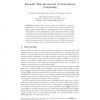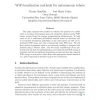403 search results - page 30 / 81 » Mapping indoor environments based on human activity |
ICSOC
2005
Springer
15 years 3 months ago
2005
Springer
Semantic Web services promise the addition of semantics annotations to Web services in a manner that enables automatic discovery, usage, and integration of services as part of ever...
103
click to vote
UIC
2009
Springer
15 years 4 months ago
2009
Springer
Abstract. In the last years, techniques for activity recognition have attracted increasing attention. Among many applications, a special interest is in the pervasive e-Health domai...
ROBOTICA
2006
14 years 9 months ago
2006
This paper compares two methods to estimate the position of a mobile robot in an indoor environment using only odometric calculus and the WiFi energy received from the wireless co...
IROS
2006
IEEE
15 years 3 months ago
2006
IEEE
— Being able to localize the origin of a sound is important for our capability to interact with the environment. Humans can localize a sound source in both the horizontal and ver...
108
click to vote
ASSETS
2006
ACM
15 years 3 months ago
2006
ACM
In previous work we have presented a prototype of an assistant system for the blind that can be used for self-localization and interactive object identification of static objects ...


